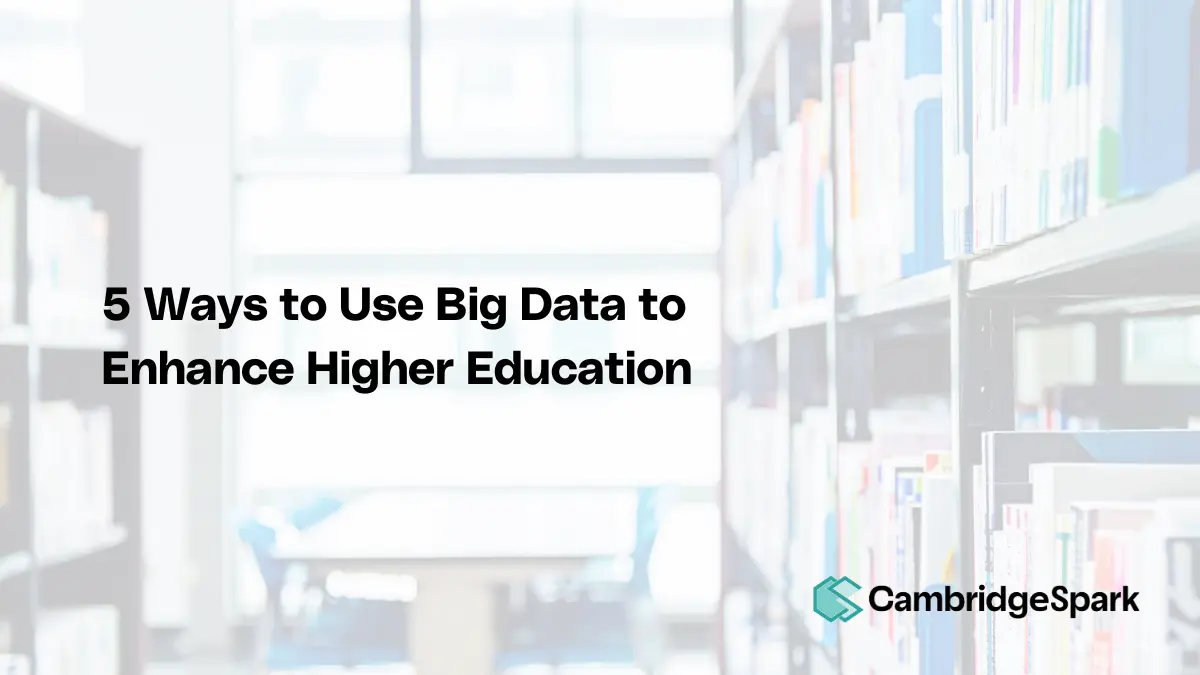The global market for big data analytics in higher education was valued at $13.58 billion in 2020 and is estimated to reach $57.14 billion by 2030.
And as educational institutions grapple with the challenges of improving their learning experiences for students, big data becomes a powerful ally.
So what exactly is “big data”?
Big data describes large sets of digital information that can be analysed to uncover patterns, trends, and connections.
Data can include a wide variety of formats, ranging from structured numerical data to unstructured text, images, and videos, each varying in quality and reliability.
The amount and complexity of big data requires the use of special technologies and analytical methods to process, understand and apply it. The goal is to enhance decision-making, grasp complex phenomena, and forecast future trends.
So let's take a look at 5 ways big data can enhance higher education:
1. Personalising experiences with big data
The one-size-fits-all approach to educational courses is quickly becoming outdated. More personalised higher ed courses have given students a more tailored educational journey, leading to greater benefits than with traditional courses.
All this is made possible by analysing big data. Analysing detailed data on individual learners' interactions, preferences, and performance allows educators to tailor their offerings to individual needs.
Adaptive learning technologies, such as Smart Sparrow, can alter content delivery in real-time based on student responses. This ensures each learner receives instruction tailored to their specific abilities and learning pace.
Technologies like this can provide useful information on how educators can teach their students more effectively too.
Some students may need extra help, whereas other students may not be being challenged enough. In such situations big data can help determine where students may need extra support, or alternatively, be given extra assignments to ensure they are reaching their full potential.
When asked how she’s seen the benefits of using data at the University of Leeds, the university’s Chief Data Officer Monica Jones said:

"We've had a student lifecycle programme running for a few years now that collects data at every stage, from the initial application, to student exams, coming to the university and going through their undergraduate, postgraduate or postdoc training. Then it’s collecting data from an employability perspective, almost as a route to market."
“University of Leeds quite often comes out near the top of the best universities for the student experience. We're pretty proud of that because we're actually listening and responding to what our customer needs are." Monica Jones, Chief Data Officer, University of Leeds
2. Improving educational content through data-driven insights
Big data also plays a crucial role in improving the quality and effectiveness of educational content used to teach students.
By analysing data on how students interact with course materials, educators can see what works and what doesn't. This analysis leads to the development of more engaging and effective content.
Specifically, big data is used in this context to understand student preferences and learning behaviours. This analysis then allows for the customisation of educational content to meet diverse learning needs.
This tailored approach ensures that content is not only more engaging but also more accessible to a wide range of learners, enhancing the overall educational experience and outcomes.
The Institute of Educational Technology (IET) conducts research into this theory by collaborating with educational institutions worldwide and with their learning design team. They gather data from virtual learning environments to gain insights into students' reactions to various learning designs.
What do we mean by a virtual learning environment?
A virtual learning environment (VLE) is an online platform in education, providing students with access to educational content. Users can access this content through computers, mobile devices, even tablets and gaming consoles. Typically, a specific educational institution, like a school, college, or university, establishes most VLEs.
By continually refining educational content based on concrete data-driven insights, institutions can stay innovative, ensuring they continue to offer highly relevant learning experiences.

3. Facilitating collaborative learning and support
Collaborative learning environments can significantly enrich the educational journey by allowing students to learn from and support each other. At the forefront of this technique is big data analytics. Big data prompts the creation of platforms equipped with collaborative features that promote an atmosphere of friendly support amongst peers.
Take, for example, the Nexus system implemented by the University of Connecticut. This system analyses academic and behavioural data to bolster student support effectively. It nurtures an active learning community where students help each other, notably through online study groups.
By using big data to refine the educational experience, these platforms can identify and group students with similar learning styles or interests, thereby maximising the effectiveness of collaborative learning.
This approach raises the quality of support available to students and also complements the overall learning experience. This type of learning dynamic also prepares students for the collaborative nature of modern work.
.webp?width=1050&height=591&name=Blog%20images%20(4).webp)
4. Enhancing the online learning experience
Since the Covid-19 pandemic began online learning became a necessary change. A change that facilitated a whole new way of learning and working.
In fact, according to a 2020 EDUCAUSE survey, the demand for student success analytics surged by 66 percent during the pandemic as most colleges and universities shifted to remote learning.
Data analytics improves the online learning experience in higher education by analysing extensive data from how students interact with online courses.
Institutions can then use these insights to customise online course content, improve teaching methods, and identify areas where students need help, facilitating timely interventions.
Data analytics can enhance the quality of online education to better meet students' learning needs. This leads to greater satisfaction and academic success.
At Cambridge Spark all our apprenticeship programmes are delivered online. It’s important to us that our learners feel like they’re part of a community and can get the right support when needed. To do this we developed EDUKATE.AI.
EDUKATE.AI is our proprietary online learning platform where learners access course materials, workshops and assignments. It also acts as a secure sandbox environment where they can apply their new skills through practical programming exercises.
Learners can receive instant feedback on their coding efforts at any time of the day, so they can make progress in their own time, day or night.
Since launching, EDUKATE.AI has assisted over 5,000 learners on their data science paths and delivered more than 550,000 pieces of feedback.
%20(1).webp?width=150&height=150&name=Dorota%20(1)%20(1).webp) "EDUKATE.Al is a fantastic platform containing all the educational aspects of the course. It’s extremely user-friendly with easy access to all learning units and videos from the workshops. The best part for me is the assignments section where you can instantly receive feedback on your code and improve it if needed. Such a helpful feature!" Dorota Kowolska, Reliability Engineer, easyJet.
"EDUKATE.Al is a fantastic platform containing all the educational aspects of the course. It’s extremely user-friendly with easy access to all learning units and videos from the workshops. The best part for me is the assignments section where you can instantly receive feedback on your code and improve it if needed. Such a helpful feature!" Dorota Kowolska, Reliability Engineer, easyJet.
5. Improving student retention rates
Big data analytics can also help improve student retention rates.
Using data to gain insights into enrollment processes, for example, means educational institutions can guide students toward courses that best align with their strengths. This targeted placement boosts the chances of student success and satisfaction from an early stage.
For instance, Gannon University applies data analytics to investigate high school performance data, helping the university predict the most suitable courses for incoming students. This proactive approach to student placement plays a crucial role in setting up students for success from the outset.
Similarly, the University of Kentucky uses predictive analytics to improve their student retention rates. One way they do this is by using predictive models to see which students may need financial aid in order for them to stay enrolled.
Without financial aid, the University of Kentucky could see from data that only 60% of students were likely to continue with their studies, whereas if financial aid was provided this increased to 75%.
Because of their data analysis efforts the university has increased first-year retention by slightly more than 4 percent, from approximately 82 percent in 2016 to 86 percent in 2020.

Conclusion
Big data in higher education allows learning institutions to take technology enhanced learning to the next level. It provides insights that tailor learning experiences, improve educational content, foster collaboration, improve online learning experiences and more.
Institutions harnessing these vast datasets optimise educational outcomes and prepare students for the modern workforce's demands.
Embracing data-driven strategies allows higher education to evolve, offering effective learning journeys. This commitment reflects not only academic excellence but also well rounded success and satisfaction for every student.
If you’re interested in upskilling your workforce in data analytics, check out our Level 4 Data Analyst Apprenticeship or get in touch with us via the form below.

-1.png)



.webp?width=1050&height=591&name=Blog%20images%20(4).webp)
%20(1).webp?width=150&height=150&name=Dorota%20(1)%20(1).webp) "EDUKATE.Al is a fantastic platform containing all the educational aspects of the course. It’s extremely user-friendly with easy access to all learning units and videos from the workshops. The best part for me is the assignments section where you can instantly receive feedback on your code and improve it if needed. Such a helpful feature!"
"EDUKATE.Al is a fantastic platform containing all the educational aspects of the course. It’s extremely user-friendly with easy access to all learning units and videos from the workshops. The best part for me is the assignments section where you can instantly receive feedback on your code and improve it if needed. Such a helpful feature!" 